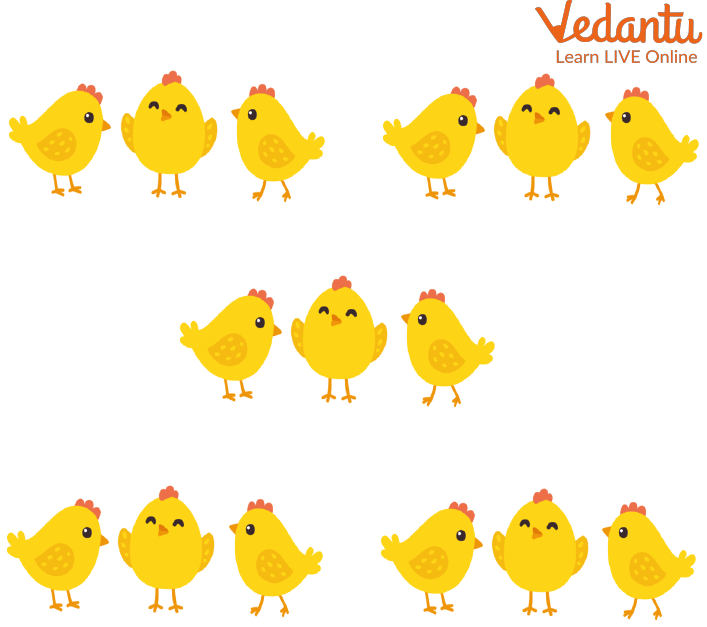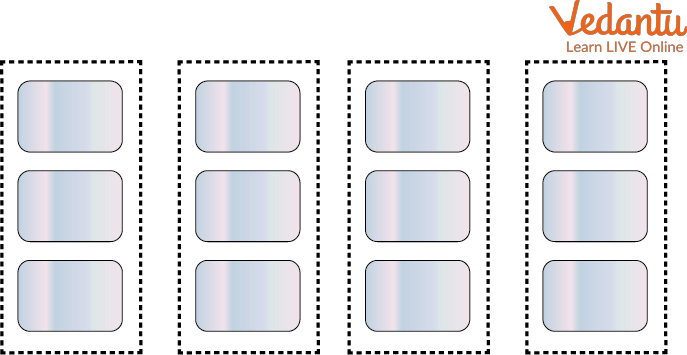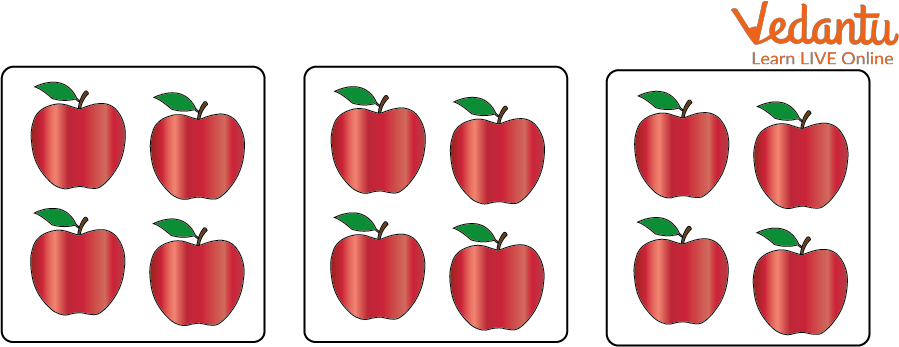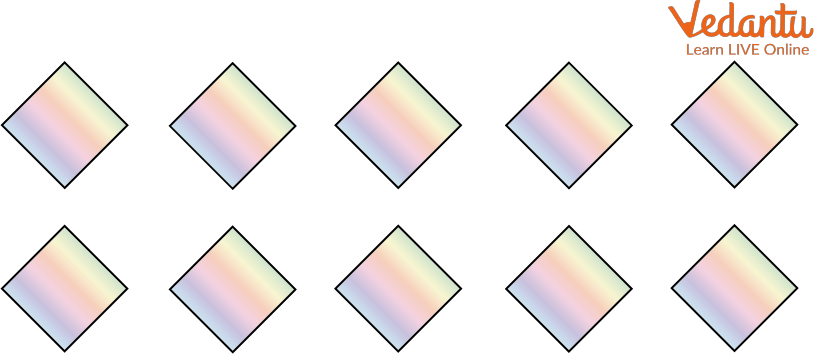




How Does Multiplication Work as Repeated Addition?
One of the four fundamental mathematical operations, addition, subtraction, multiplication, and division, is multiplication. Multiplication is a process of repeated addition of sets of identically sized objects. Let's use ice cream as an example to better understand.

Group of Ice-creams
There are two such groupings, each with three ice creams.
6 ice creams total $(3 + 3)$.
You did, however, add two groups of three ice creams. You have therefore multiplied three ice creams by two. It can alternatively be expressed as $(2 \times 3) = 6$.
As we can see, $(2 \times 3)$ and $(3 + 3)$ are equivalent.
Power is a term where multiplication is repeated. The exponent, 2, and base, 5, respectively, are both numbers. The number of times the base is employed as a factor is represented by the exponent.
What is Repeated Addition?
The technique of repeated addition involves combining equal groups. See the diagram below. There are 3 chickens in each of the 5 groups on the diagram.

Pairs of Chicken
The following repeated addition statement can be used to indicate the overall quantity of oranges: $(3 + 3 + 3 + 3 + 3) \text { or } 15$
Repeated Addition Examples
Let’s give a look at other repeated addition examples.
Example 1. Calculate the total number of boxes in the figure.

Four Group of Three Boxes
Ans: There are 3 boxes in each column and there are 4 columns.
$\text { So, }(3 + 3 + 3 + 3) = (4 \times 3) =12$
Example 2. Each of Raj’s three boxes of markers contains five markers. How many markers does raj have now?
Ans: Each box with five markers indicates that the number five has been repeated three times.
$(5 + 5 + 5) =15 \text { or, }$
This can be represented as an additional formula: $3 \times 5$ equals 15, which is another way to write this as a multiplication phase.
Raj has a total of 15 markers.
Multiplication is Repeated Addition
Multiplication is a repeated Addition that involves joining like groups together. If the same precise number is repeated, repeated addition can be expressed as multiplication. For example,

Three Group of Four Apples
In the above diagram, three groups of four apples are there. We can also write them as $(4 + 4 + 4) = (3 \times 4) = 12$.
Learn the multiplication facts by repeating the addition. If you are unfamiliar with the facts for $7 \times 3$, for instance, you might find it simpler to calculate $(7 \times 3)$ by writing $(3 + 3 + 3 + 3 + 3 + 3)$ or $(7 + 7 + 7)$; and then gradually adding. It might be useful when dealing with bigger numbers, such as $(5 \times 40)$. Writing $(40 + 40 + 40 + 40 + 40 + 40)$ and then adding the tens is more convenient.
Example: Three muffin packages were bought by Andrew. Four muffins were included in each packet. What number of muffins did Andrew buy?
Ans: In numerical notation, three packages of four muffins each can be written as $(3 \times 4)$ or $(4 + 4 + 4)$, which is 12.
In total, Andrew purchased 12 muffins.
Practice Question
1. Calculate the total number of boxes in the figure.

Group of Boxes
Ans: 10
2. Two pen pockets were bought by Adda. Four pens were included in each packet. What number of pens did Adda buy?
Ans: 8
Summary
Multiplication is a process of repeated addition of sets of identically sized objects. The technique of repeated addition involves combining equal groups. Multiplication is repeated addition which involves joining like groups together. When the same precise number is repeated, repeated addition can be expressed as multiplication.
FAQs on Multiplication as Repeated Addition Explained
1. What does it mean when we say 'multiplication is repeated addition'?
This means that multiplying two numbers gives the same result as adding one number to itself multiple times. For example, 4 x 3 is just a short way of writing 3 + 3 + 3 + 3. Both will give you the answer 12. It's the basic idea behind what multiplication does.
2. Can you give a simple example of solving a multiplication problem with repeated addition?
Certainly! Let's solve 5 x 2. Using repeated addition, this means we need to add the number 2, five times. So, the problem looks like this: 2 + 2 + 2 + 2 + 2 = 10. This shows that 5 x 2 is just a faster way to get the answer 10.
3. Why do we learn multiplication if we can just use addition?
We learn multiplication because it is a much faster and more efficient shortcut. While adding works for small numbers, it becomes very slow for bigger problems. For instance, calculating 20 x 5 by adding 5 twenty times would take a long time and increase the chances of making a mistake.
4. Where might I use the concept of multiplication in real life?
You use multiplication in many daily situations, such as:
- Calculating the total amount of money if you have 5 notes of ₹10 each (5 x 10).
- Finding the total number of candies in 4 packets if each packet has 6 candies (4 x 6).
- Figuring out the total wheels on 3 autorickshaws (3 x 3).
5. What are the most important basic rules of multiplication?
Here are a few key rules to remember that make multiplication easy:
- Any number multiplied by zero always equals zero (e.g., 8 x 0 = 0).
- Any number multiplied by one is always the number itself (e.g., 15 x 1 = 15).
- Changing the order of the numbers does not change the answer. For example, 4 x 6 is the same as 6 x 4.
6. How is multiplication different from division?
Multiplication and division are opposites. Multiplication is repeated addition used to combine equal groups. In contrast, division is like repeated subtraction, used to split a larger amount into equal smaller groups. If 3 x 4 = 12 combines groups, then 12 ÷ 3 = 4 separates them.
7. Is it true that any multiplication problem can be solved with repeated addition?
Yes, for whole numbers, any multiplication can be seen as a repeated addition problem. This is the foundational concept that helps us understand how multiplication works. However, as numbers get larger, using multiplication tables becomes much more practical and less time-consuming than adding repeatedly.
8. How does 5 x 3 look different from 3 x 5 when using repeated addition?
Although they give the same answer, they represent different groupings:
- 5 x 3 means adding 3 five times: 3 + 3 + 3 + 3 + 3 = 15.
- 3 x 5 means adding 5 three times: 5 + 5 + 5 = 15.
This demonstrates an important multiplication rule that the order of factors does not change the final product.











